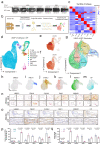Serglycin secreted by late-stage nucleus pulposus cells is a biomarker of intervertebral disc degeneration
- PMID: 38167807
- PMCID: PMC10761730
- DOI: 10.1038/s41467-023-44313-9
Serglycin secreted by late-stage nucleus pulposus cells is a biomarker of intervertebral disc degeneration
Abstract
Intervertebral disc degeneration is a natural process during aging and a leading cause of lower back pain. Here, we generate a comprehensive atlas of nucleus pulposus cells using single-cell RNA-seq analysis of human nucleus pulposus tissues (three males and four females, age 41.14 ± 18.01 years). We identify fibrotic late-stage nucleus pulposus cells characterized by upregulation of serglycin expression which facilitate the local inflammatory response by promoting the infiltration of inflammatory cytokines and macrophages. Finally, we discover that daphnetin, a potential serglycin ligand, substantially mitigates the local inflammatory response by downregulating serglycin expression in an in vivo mouse model, thus alleviating intervertebral disc degeneration. Taken together, we identify late-stage nucleus pulposus cells and confirm the potential mechanism by which serglycin regulates intervertebral disc degeneration. Our findings indicate that serglycin is a latent biomarker of intervertebral disc degeneration and may contribute to development of diagnostic and therapeutic strategies.
© 2024. The Author(s).
Conflict of interest statement
The authors declare no competing interests.
Figures







Similar articles
-
Differential proteomic analysis of fetal and geriatric lumbar nucleus pulposus: immunoinflammation and age-related intervertebral disc degeneration.BMC Musculoskelet Disord. 2020 Jun 2;21(1):339. doi: 10.1186/s12891-020-03329-8. BMC Musculoskelet Disord. 2020. PMID: 32487144 Free PMC article.
-
M6A methylation-regulated autophagy may be a new therapeutic target for intervertebral disc degeneration.Cell Biol Int. 2024 Apr;48(4):389-403. doi: 10.1002/cbin.12135. Epub 2024 Feb 5. Cell Biol Int. 2024. PMID: 38317355 Review.
-
Integrated transcriptome and proteome analyses identify novel regulatory network of nucleus pulposus cells in intervertebral disc degeneration.BMC Med Genomics. 2021 Feb 3;14(1):40. doi: 10.1186/s12920-021-00889-z. BMC Med Genomics. 2021. PMID: 33536009 Free PMC article.
-
Hesperidin mitigates oxidative stress-induced ferroptosis in nucleus pulposus cells via Nrf2/NF-κB axis to protect intervertebral disc from degeneration.Cell Cycle. 2023 May;22(10):1196-1214. doi: 10.1080/15384101.2023.2200291. Epub 2023 Apr 13. Cell Cycle. 2023. PMID: 37055945 Free PMC article.
-
Achilles' Heel-The Significance of Maintaining Microenvironmental Homeostasis in the Nucleus Pulposus for Intervertebral Discs.Int J Mol Sci. 2023 Nov 22;24(23):16592. doi: 10.3390/ijms242316592. Int J Mol Sci. 2023. PMID: 38068915 Free PMC article. Review.
Cited by
-
Role of macrophage in intervertebral disc degeneration.Bone Res. 2025 Jan 23;13(1):15. doi: 10.1038/s41413-024-00397-7. Bone Res. 2025. PMID: 39848963 Free PMC article. Review.
-
ELF1-mediated transactivation of METTL3/YTHDF2 promotes nucleus pulposus cell senescence via m6A-dependent destabilization of E2F3 mRNA in intervertebral disc degeneration.Cell Death Discov. 2025 Jun 4;11(1):267. doi: 10.1038/s41420-025-02515-8. Cell Death Discov. 2025. PMID: 40467575 Free PMC article.
-
TRIM29 alleviates intervertebral disc degeneration through the PI3K/AKT/mTOR pathway.Sci Rep. 2025 Jul 10;15(1):24797. doi: 10.1038/s41598-025-10272-y. Sci Rep. 2025. PMID: 40634479 Free PMC article.
-
Applications and techniques of single-cell RNA sequencing across diverse species.Brief Bioinform. 2025 Jul 2;26(4):bbaf354. doi: 10.1093/bib/bbaf354. Brief Bioinform. 2025. PMID: 40698863 Free PMC article. Review.
-
Self-healing hydrogels loaded with Spatholobi Caulis alleviate disc degeneration by promoting autophagy in nucelus pulposus.Mater Today Bio. 2024 Nov 8;29:101323. doi: 10.1016/j.mtbio.2024.101323. eCollection 2024 Dec. Mater Today Bio. 2024. PMID: 39624051 Free PMC article.
References
-
- Roberts S, Evans H, Trivedi J, Menage J. Histology and pathology of the human intervertebral disc. J. Bone Jt. Surg. Am. 2006;88:10–14. - PubMed
Publication types
MeSH terms
Substances
Grants and funding
- 81972098/National Natural Science Foundation of China (National Science Foundation of China)
- 82002341/National Natural Science Foundation of China (National Science Foundation of China)
- 2022A1515010341/Natural Science Foundation of Guangdong Province (Guangdong Natural Science Foundation)
- 2019A1515110142/Natural Science Foundation of Guangdong Province (Guangdong Natural Science Foundation)
LinkOut - more resources
Full Text Sources
Molecular Biology Databases

